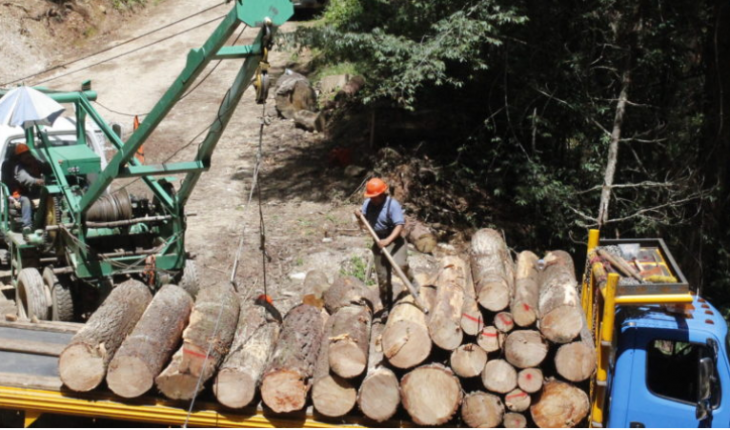The environmental crisis that Mexico has lived in for years, and which is reflected in the advancement of deforestation or biodiversity loss, was not an issue that was addressed in 2020. Scientists and activists agree that this year confirmed that there is a disdain, from the government, towards the environmental agenda.
In December 2018, when the presidency of Andrés Manuel López Obrador began, called the “Fourth Transformation”, in the scientific field it was already proposed that there was an environmental crisis in Mexico and that it was necessary to chart a route to reverse this situation.
Read: Latin America: region where more environmental defenders were killed in 2019
Even in October 2019, an interdisciplinary group meeting around the University Seminar on Society, Environment and Institutions (SUSMAI) published a book outing ways to address issues such as loss of ecosystems and biodiversity, pollution, lack of investment in renewable energy, access to quality water, soil erosion, depletion of , the destruction of mangroves and the increasing illegality in forest harvesting.
In the presentation of the book, the then secretary of environment and natural resources, biologist Victor Toledo acknowledged that it was necessary to declare an “environmental emergency” in the country.
2020 ended and another emergency, that of the COVID-19 pandemic, was the protagonist of the year. Public policies were not brought to the attention of the environmental crisis. The best reflection of this was that even before the pandemic the budget for the entire environmental sector was reduced and the Ministry of Environment and Natural Resources (Semarnat) has been the unit that has experienced the most changes: in two years they have had three different headlines.
The small progress made on the environmental agenda during 2020, such as the ratification of the Escazu Agreement, is blurred by the advancement of deforestation, aggressions against environmental defenders, or an energy policy that bets on fossil fuels and ignores environmental consequences.
What’s troubling: a blow to the environmental sector
Over the past five years, Mexico has seen the environment budget plummet: if in 2015 the entire environmental sector had 67.976 million pesos ($3 billion), by 2020 that figure fell to 29.869 million pesos ($1.5 billion).
This well-known budget led to the Semarnat, but also the National Commission on Protected Natural Areas (Conanp), the National Forestry Commission (Conafor) and the Federal Office for Environmental Protection (Profepa) working with minimal resources.
In addition, in April 2020—when the COVID-19 pandemic was already installed in the country—a decree was issued for all federal government agencies to make even more budget adjustments, as no resources would be allocated for office, stationery, gasoline or travel income.
For Dr. Leticia Merino, coordinator of the University Seminar on Society, Environment and Institutions (SUSMAI), the reduction of the budget led to “a dismantling of environmental institutions”, the units were left with no capacity to carry out their functions, including surveillance to combat environmental crimes.
Gustavo Alanís, Director of the Mexican Center for Environmental Law (CEMDA), highlights the case of the Conanp, a unit responsible for safeguarding 182 protected natural areas of the country, which represent 90 million hectares of the national territory: if in 2016 it reached 74 pesos (just over three dollars) per hectare, by 2020 it had only 9.56 pesos (half a dollar) per hectare in its charge. “Without sufficient budget, any efforts shether to make, from the public sector, for the implementation of environmental law are nullified.”
Alanís also mentions the case of profepa, which, by losing 60% of its budget, cannot carry out its inspection and surveillance functions: “a great deal of environmental crimes are being committed in total impunity.”
The austerity that applies to environmental units is not addressed on other issues to which the federal government directs the floodlights.
The construction of the Dos Bocas refinery, to which 41 billion pesos ($2 billion) was earmarked, or Sowing Life, which received almost the same budget as the entire environmental sector. This programme, run by the Welfare Secretariat, consists of providing monthly financial support to those who make fruit and timber tree plantations.
Dr. Exequiel Ezcurra, a professor at the University of California Riverside and who has received several awards for its research work and boost to the conservation of different ecosystems, notes that while it is applaudable to reforest the area of the Mexican tropics, the program has its “light-dark. In some areas, Sowing Life is driving monocultures—like teca tree—that don’t help recover the ecosystem services of the jungle.”
For Dr. Leticia Merino, the uneven distribution of the budget only shows an awareness of the environmental issue: “It is believed that taking care of the environment is equal to planting fruit trees… Sowing Life is an agroforestry program, which can be laudable in places where there is a lot of deterioration, but it is actually a clientery program. The environmental is not understood and there is no interest in the subject.”
The disturbing: a weakened secretariat
In 2020 it became even clearer that inside López Obrador’s cabinet there are strong pressures not to move forward on environmental issues. And the episode that showed this fight was the resignation of Victor Toledo Manzur as holder of the Semarnat.
During the year and three months he was at the helm of the Semarnat, Toledo Manzur concentrated much of his work on promoting agroecology and banning the use of several herbicides, mainly glyphosate. In November 2019, it stopped imports of this product, an action that pitted it against several members of the cabinet and the agro-industrial sector.
The importation of glyphosate at the end of November 2019 was denied in Mexico. Photo: Courtesy Semarnat
At the end of August, Toledo Manzur submitted his resignation as holder of the Semarnat; after an audio was leaked mentioning that the fourth transformation “is full of contradictions” and that cabinet members favor agribusiness and mining.
Since September 2020, the holder of the Semarnat is María Luisa Albores, who was at the head of the Secretariat of Welfare and in charge of the Sembrando Vida program. For this text, Mongabay Latam requested an interview with the Semarnat, but no response was received.
Life sciences doctor and ecotoxicology specialist Omar Arellano, who is part of the group of scientists promoting the prohibition of hazardous substances, notes that there have been many pressures inside and outside the cabinet so that no progress is made on issues such as the prohibition of hazardous chemicals, including glyphosate.
The researcher recalls that even the Federal Commission for the Protection of Health Risks (Cofepris) undertook to have stricter regulation for 183 hazardous substances and to update the pesticide catalogue. “Nothing really happened. Everything stayed in the speech.” With the advent of the pandemic by COVID-19, he notes, “the environmental sector was greatly weakened. It does not curd an environmental policy that is truly restorative and containment.”
Debt: blurred climate agenda
In Mexico, not only is a new refinery built in tabasco state, right on land where there was once a mangrove; resources have also been earmarked for the modernization of coal, diesel, gas and oil-powered power plants.
These projects show that “the momentum of clean energy was turned its back and the issue of climate change is gone. Efforts are aimed at boosting the use of fossil energy and curbing renewable energy. Actions contrary to a climate policy are promoted to advance the fulfillment of international commitments, including the Paris Agreement,” says Adrián Fernández Bremauntz, PhD and executive director of mexico’s Climate Initiative.
Among the commitments that Mexico made, and which were established in the General Law on Climate Change, are to reduce its greenhouse gas emissions by 50% of the 2000 levels by 2050; as well as having zero deforestation by 2030.
One step after the end of the year, on December 14, the Mexican government updated Nationally Determined Contributions (NDCs); that is, the country’s targets for reducing greenhouse gas emissions, which have been the same as since 2015.
The publication of the Special Climate Change Programme 2020-2024, approved since August, was still pending in mid-December.
Researcher Exequiel Ezcurra recalls that in Felipe Calderón’s six-year period and then with Enrique Peña Nieto they were boosted to renewable energy, but not by an environmental interest: “It was only sought to benefit large companies; renewables have been seen as a business of large corporations and not as an opportunity to empower communities or citizens.”
However, Dr. Ezcurra points out that the path that Lopez’s administration took Obrador, by placing fossil fuels as a development lever for the country, “will have strong impacts on the environment in the long run.”
For Ezcurra, building the Dos Bocas refinery in the Tabasco lowlands is a cause for concern for several reasons. The first is the environmental impact it is already generating in this region of coastal lagoons and mangroves: “that environmentally fragile area is going to transform into an industrial landscape”.
The researcher’s second concern has as its livelihood scientific studies in which he participated and show that, during the last interglacial stage, that area was underwater. “That area is going to flood, as happened last November. It will keep flooding,” he warns.
The Bad: Deforestation Spreads
Mexico ranks among the ten countries that have lost the most primary forests globally, according to the latest study by the University of Maryland, published by Global Forest Watch (GFW). In 2019, the country ran out of 65,000 hectares of primary forests, the highest figure documented since 2001.
The trend continues in 2020, as observed by researchers and non-governmental organizations working on the subject and who, at the end of November 2020, participated in a conservatory on deforestation organized by the Academic Observatory of Society, Environment and Institutions of the National Autonomous University of Mexico (UNAM).
The serious: killings of environmental defenders
Mexico is among the four most dangerous countries for environmental defenders, after the Philippines, Colombia and Brazil, according to the report that the Global Witness organization submitted in July 2020. In the country, 19 environmental and territory defenders were murdered in 2019.
In 2020, violence against environmental defenders continued. The year began with news of the disappearance of Homero Gómez González, defender of the monarch butterfly, who two weeks later was found dead.
Even the COVID-19 pandemic was not enough to inhibit aggression against environmental and territory defenders. Between April and May Adam Vez Lira, defender of a mangrove area, was killed in Veracruz; Isaac Herrera Avilés, a lawyer who defended a wooded area in Jiutepec, Morelos, and Eugui Roy Martínez Pérez, a biology student in Oaxaca.
Read the full report on Mongabay Latam
What we do at Animal Politics requires professional journalists, teamwork, dialogue with readers and something very important: independence. You can help us keep going. Be part of the team.
Subscribe to Animal Politics, receive benefits and support free journalism.#YoSoyAnimal
translated from Spanish: Mexico’s environmental debts: advocates, budget and COVID
December 20, 2020 |





